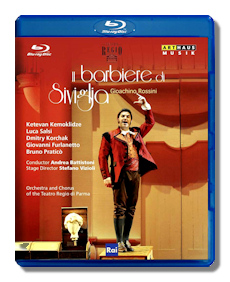
The Internet's Premier Classical Music Source
Related Links
- Rossini Reviews
- Latest Reviews
- More Reviews
-
By Composer
-
Collections
DVD & Blu-ray
Books
Concert Reviews
Articles/Interviews
Software
Audio
Search Amazon
Recommended Links
Site News
 Blu-ray Review
Blu-ray Review
Gioachino Rossini

Il Barbiere di Siviglia
- Rosina - Ketevan Kemoklidze
- Figaro - Luca Salsi
- Il Conte d'Almaviva – Dmitry Korchak
- Bartolo - Bruno Praticò
- Don Basilio - Giovanni Furlanetto
- Fiorello - Gabriele Bolletta
- Ambrogio – Noris Borgogelli
- Berta - Natalia Roman
Orchestra & Chorus of the Teatro Regia di Parma/Andrea Battistoni
Chorus Master – Martino Faggiani
Stage Director – Stefano Vizioli
Sets – Francesco Calcagnini
Costumes – Annemarie Heinreich
Lighting – Franco Marri
Director for TV & Video – Daniela Vismara
Recorded live at the Teatro Regio di Parma, 2011
Arthaus Musik/Kultur Blu-ray BD4540 170m 1080i LPCM Stereo DTS-HD Master Audio
Also available on DVD D4540: Amazon - UK - Germany - Canada - France - Japan - ArkivMusic - CD Universe - JPC
Conductor Andrea Battistoni (b. 1987) leads a very spirited and colorful performance of this Rossini classic. A mere twenty-three or twenty-four at the time of this 2011 staging, he is obviously a talent to watch, and it is hardly surprising that he imparts such a fresh, youthful character to the score. The orchestra and chorus respond with total commitment to his baton and really cannot be faulted in any way. But, you ask, what about the singers?
Well, Battistoni is abetted by an excellent cast, which includes a splendid Rosina in the person of the Georgian-born Ketevan Kemoklidze, whose voice has a robust yet velvety tone that relatively few mezzo-sopranos have. Winner of the prestigious competition Operalia, she debuted in Tbilisi as Maddalena in Verdi's Rigoletto in 2002 and has steadily gained currency in the major opera houses in Europe and the US since. Try her brilliant Act II Contro un cor che accende amore, which is quite a challenging number. Baritone Luca Salsi, also a major competition winner (Viotti International Song Competition), makes a splendid Figaro. He delivers a very spirited Largo al factotum (Act I) and is simply marvelous throughout. Bruno Pratico, as Bartolo is also excellent, with just the right kind of vocal resources and fine comedic sense. Russian tenor Dmitry Korchak was, coincidentally, also a prizewinner in a past Operalia competition and he makes a more than an adequate Count Almaviva. But he is a little less imposing in his dramatic skills, though his voice is attractive, if a tad on the nasal side. The remainder of the cast is also fine. To sample a couple of the many thrilling ensemble numbers in this performance, try the rousing effort closing out the First Act, Ma signor…ma un dottor or the Act II quartet Orsu, signor Don Bartolo.
The sets in this production by Stefano Vizioli are rather sparse, at least in the opening scene, which takes place in the street outside Bartolo's house. When, however, the action moves to the house's interior in the following scene the atmosphere brightens, not least because of that utterly massive pile of huge books on the right side of the stage, which imparts a comic, fantasy-world look. (If you pulled one book out from the bottom, those hundreds crowding the rafters would probably tumble down with fatal results!) Actually, the sets are relatively modest throughout, but are mostly very subtle and atmospherically effective. The costumes are of the period and the lighting, with lots of reds often flooding the stage, is quite imaginative.
The camera work is fine throughout and the sound reproduction is vivid and well balanced. All in all, this is a fine effort. I reviewed another video performance of The Barber of Seville here in 2004 (TDK EuroArts DVD 205124-9). Released on the EuroArts label, it was led by Nello Santi and featured Vesselina Kasarova as Rosina and Manuel Lanza as Figaro. I found it a splendid effort in just about every respect, but cautioned readers that it was an updated take on the work, placing the action in the 20th century. This new production features singing that rivals that older production's and is more traditional in its treatment of the opera. Depending on your personal tastes then, either version would serve as an excellent choice.
Copyright © 2013, Robert Cummings





















